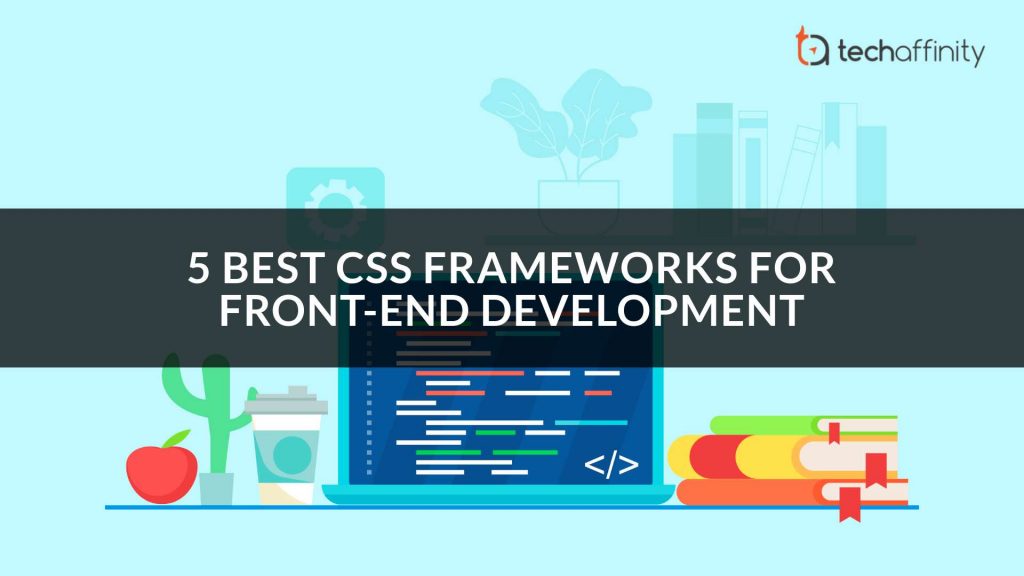5 Best CSS Frameworks for Front-End Development

Author : John Prabhu 8th Aug 2019
Before getting started with the CSS frameworks, let’s have a brief look at CSS itself. Cascading Style Sheet, popularly known as CSS, is significantly used by front-end developers to control and beautify the appearance of HTML elements. CSS frameworks play a huge role in building websites that are device-agnostic and possesses a stunning UI. Meticulous pick of the right framework helps in extracting the most out of the incredible Cascading Style Sheet (CSS).

THINGS TO CONSIDER WHILE CHOOSING CSS FRAMEWORKS
- Make sure you try and test the CSS front-end frameworks for performance before implementing it in your development process.
- With the ever-changing IT landscape, it is mandatory to check for the updates it received in the recent past. If regular updates are released, you might be receiving further updates as well, and thus you don’t fall behind.
- Take proper measures before choosing your CSS framework in terms of popularity. It implies that there is a pool of developers who use that particular front-end framework.
- Cautiously choose your framework that doesn’t have a higher degree of specificity. It is better to go with a broad solution for easy customization of your framework with new rules. Hence, choose a framework with minimum specificity.
- Check whether your chosen framework provides great documentation features to enhance the learning process.
Here are some of the majorly used CSS frameworks by the front-end fraternity:
1. MATERIALIZE – Framework Based on Material Design by Google
Materialize is one of the renowned CSS frameworks available in the front-end development sphere. It is based on Material Design by Google. It is rich in providing various functionalities such as autocomplete, waves, slide navigation, and more.
Materialize helps in creating incredible design features. It is loaded with features to build highly responsive designs and a lot of documentation too. Moreover, you can define the visual interactions of UX elements to deliver an enhanced experience to your users.
2. BOOTSTRAP – Free and Open-source CSS Framework
Bootstrap is another commonly used CSS framework that is intended to create & deliver mobile-first design for CSS, HTML, and JavaScript. Since the framework has a 12-column grid, it is a handy option for complicated HTML5 development. Also, it offers a wide variety of web components like responsive navigation, carousel, tabs, and more.
Bootstrap offers a pleasing and consistent UI experience similar to the earlier discussed framework – Materialize. Bootstrap is loaded with an array of premium and free themes, plugins, and templates. Also, it helps in the easy fixing of CSS compatibility issues and is supported by almost every online browser.
3. BULMA – Free, Open-source, & Modern CSS Framework Based on Flexbox
Bulma is a renowned and widely used framework by the front-end developers. It is a complete solution as it has strong community support. The framework is compatible across various web browsers. Bulma is relatively simple to use and is an effective framework for CSS development. As it is lightweight and comes with Flexbox features integrated, it makes a lot of front-end design and development easy.
4. KUBE – CSS & JS Framework
Kube supports a lot of top web-browsers and is widely used to build beautiful and device-agnostic website designs. It is a popular CSS framework that helps in accelerating the website development process with a host of templates and styles. As this particular framework is based on Flexbox, it offers a lot of functionalities and features which helps in enhancing the design layout.
When it comes to the benefits of using Kube, its files are lightweight, easy to use, and provides all the important resources and tools. All these resources and tools ease the development process of websites to a greater extent. Kube is a great framework to consider while building your website as it acts as a platform to explore numerous CSS options.
5. PURE CSS – Responsive Framework for Web Apps
In the current market scenario, among other CSS front-end frameworks, Pure CSS is the widely used framework because of its simplicity and smaller file size. It works exceptionally well with new projects and comes with numerous project build features that help in offering easy access to the CSS resets. For an even more seamless cross-browser compatibility, it has the normalize.CSS file integrated into it.
With Pure CSS, additional files can be included through a single style sheet as the framework isn’t heavy in terms of size. The development process has been simplified and is faster as it can enable access to the CSS files even via a CDN (Content Delivery Network).
Depending on the nature, purpose, and requirement of the website style, the choice of frameworks alter. Expert consultation combined with a deep understanding of the frameworks, and requirement helps in identifying the best framework for front-end development. CSS helps in giving an aesthetic look to your website, and thus, it is vital to your website development.
We, at TechAffinity, are providing expert services for web development and possess hands-on experience on such CSS frameworks. Contact us to schedule a free consultation so that we can help in assisting you with the best web development services. Drop an email at media@techaffinity to take things further.
